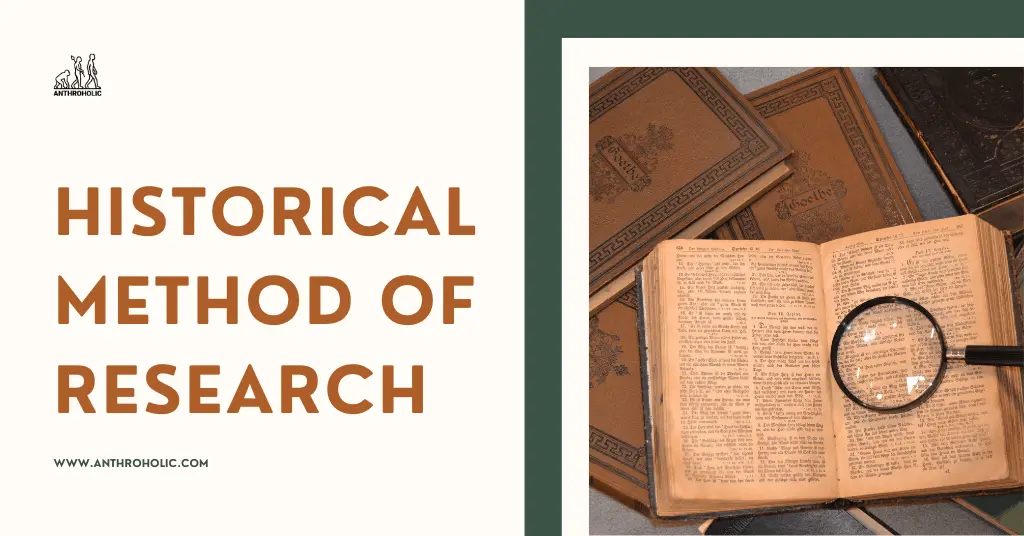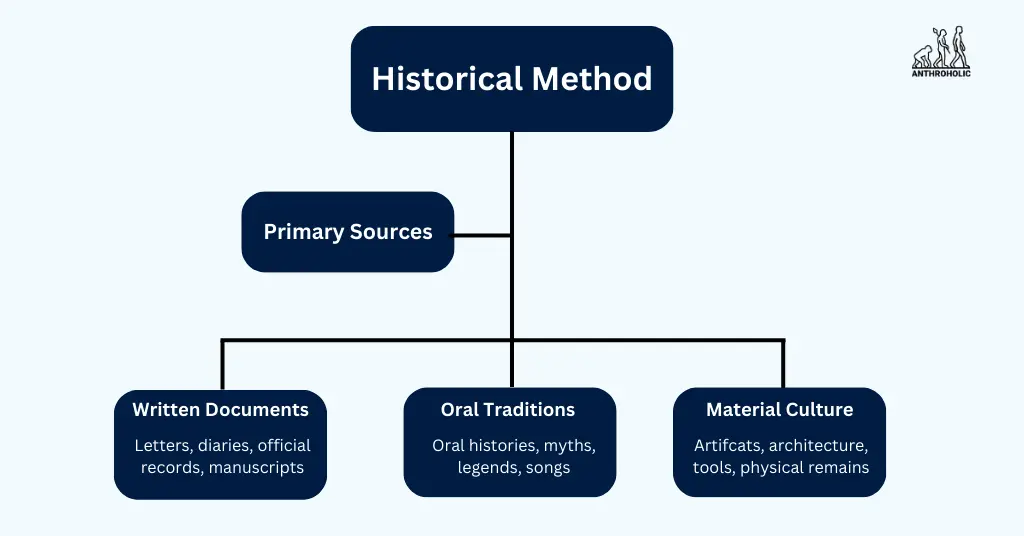AI Answer Evaluation Platform Live Now. Try Free Answer Evaluation Now
Historical Method of Research
The historical method is a systematic approach used by anthropologists to study and understand the past. It involves the critical examination and interpretation of historical sources such as documents, artifacts, oral traditions, and other forms of evidence to reconstruct events, processes, and patterns of human behavior. The purpose of the historical method is to gain insights into the dynamics of societies and cultures over time, allowing anthropologists to analyze continuity and change, identify patterns of social, economic, and political development, and comprehend the complexities of human experiences in different historical contexts [1].

Importance in Anthropology
The historical method holds significant importance in anthropology as it provides a framework for investigating and comprehending the cultural, social, and environmental factors that have shaped human societies. By employing this method, anthropologists can gain a deeper understanding of how past events and processes have influenced contemporary societies and shed light on the roots of cultural practices, social structures, and belief systems. It allows for the identification of long-term trends, cultural interactions, and the impact of colonization, migration, and globalization on diverse communities.
Evolution of the Historical Method
The historical method has evolved over time, reflecting changes in theoretical perspectives and advancements in research techniques. Early anthropologists primarily relied on written documents and archaeological findings to reconstruct history. However, with the emergence of postmodern and critical approaches, the historical method expanded to include the perspectives and experiences of marginalized groups, challenging dominant narratives and incorporating oral history and alternative sources.
For instance, in studying the history of indigenous communities, anthropologists have incorporated indigenous knowledge systems, oral traditions, and communal memory alongside conventional written sources. This anthropologically acceptable approach acknowledges the agency and voices of indigenous peoples, contributing to a more inclusive and comprehensive understanding of history.
Furthermore, the integration of interdisciplinary approaches, such as ethnography and historical archaeology, has enriched the historical method. Ethnographic studies provide valuable insights into the social and cultural contexts of past events, complementing traditional historical sources. Historical archaeology allows anthropologists to unearth material remains and artifacts, providing tangible evidence to corroborate or challenge historical narratives.
Overall, the historical method is a vital tool in anthropological research, enabling scholars to reconstruct the past and uncover the complex interplay of social, cultural, and environmental factors. By adopting an anthropologically acceptable approach, incorporating diverse sources and perspectives, anthropologists can contribute to a more nuanced understanding of history and its implications for contemporary societies.
Key Concepts in Historical Methodology
Primary Sources
Primary sources are original records or artifacts that provide firsthand information about past events, cultures, and individuals. They serve as direct evidence of the historical period being studied. Anthropologists utilize various types of primary sources to reconstruct and interpret history.
- Written Documents: These include letters, diaries, official records, and manuscripts. For example, the letters exchanged between anthropologists and indigenous informants provide valuable insights into cultural practices and social dynamics.
- Oral Traditions: Oral histories, myths, legends, and songs are examples of oral traditions that transmit knowledge across generations. Anthropologists carefully analyze and interpret these narratives to understand cultural beliefs and historical events.
- Material Culture: Artifacts, architecture, tools, and other physical remains are essential primary sources. They offer tangible evidence of past activities, technologies, and social practices. For instance, the analysis of pottery fragments helps reconstruct trade networks and cultural interactions.

Reliability and Limitations
While primary sources are valuable, they also possess inherent limitations and biases. Anthropologists critically evaluate their reliability by considering factors such as the context of production, the intentions of the creator, and potential distortions over time.
For instance, written documents may reflect the perspectives of the dominant group or contain biases and omissions. Researchers must assess the author’s background, purpose, and potential political or social agenda. Additionally, oral traditions may undergo changes during transmission, making it crucial to consider the context and cultural meanings embedded within the narratives.
Secondary Sources
Importance and Usage
Secondary sources are works that analyze and interpret primary sources. They include scholarly books, journal articles, and historical accounts written by other researchers. Secondary sources provide valuable insights, interpretations, and analyses, making them essential in historical research.
Anthropologists use secondary sources to gain a broader understanding of historical contexts, theories, and debates. They help situate primary sources within larger frameworks and provide interpretations that go beyond individual perspectives. For example, secondary sources may offer comparative analyses of similar historical events in different regions, shedding light on patterns and trends.
Evaluating Secondary Sources
Anthropologists must critically evaluate secondary sources to ensure their accuracy, objectivity, and relevance to their research. They assess the author’s qualifications, methodology, and potential biases. It is important to consider multiple perspectives and compare findings from different secondary sources.
Moreover, the citation and referencing of primary and secondary sources are crucial in maintaining academic integrity and acknowledging the contributions of previous scholars. Proper citation allows for the traceability of information and facilitates the verification of claims and arguments.
Hence, primary and secondary sources are fundamental concepts in historical methodology. Anthropologists employ primary sources, such as written documents, oral traditions, and material culture, to reconstruct the past. They critically evaluate their reliability and limitations. Secondary sources play a crucial role in providing interpretations and analyses of primary sources. Evaluating secondary sources and properly citing all sources contribute to the rigor and credibility of anthropological research.
Analyzing and Interpreting Historical Data
Contextualizing Historical Events
Social, Political, and Cultural Contexts
Contextualizing historical events is a crucial step in anthropological research, as it involves understanding the social, political, and cultural factors that shaped and influenced these events. Anthropologists recognize that historical events do not occur in isolation but are interconnected with broader social dynamics. By examining the social context, they aim to identify the power structures, social hierarchies, and societal norms that played a role in historical developments [1].
For example, when analyzing a historical conflict between indigenous communities and colonial powers, anthropologists consider the complex social dynamics at play. They examine how colonial policies, economic interests, and ideologies influenced the interactions between these groups. This analysis helps to understand the motivations, strategies, and outcomes of the conflict.
Furthermore, understanding the cultural context is essential for interpreting historical events. Anthropologists delve into the beliefs, values, and practices of the societies under study. For instance, analyzing religious rituals, artistic expressions, and social customs can provide valuable insights into the cultural worldview of a particular time period. By considering the cultural context, anthropologists can uncover the meanings and symbolism associated with historical events.
Comparative Analysis
Anthropologists often engage in comparative analysis to gain a broader perspective on historical events. By examining similar events or phenomena across different regions or time periods, they can identify patterns, similarities, and differences. Comparative analysis allows anthropologists to discern the factors that are specific to a particular context and those that are more universal or recurrent.
For example, anthropologists studying the impact of industrialization on different societies may compare the experiences of communities in various regions. They can examine the social, economic, and environmental consequences of industrialization and identify common patterns of transformation, as well as unique responses and outcomes.
Constructing Narratives
Narrative Structures
Constructing narratives is a fundamental aspect of analyzing and interpreting historical data in anthropology. Anthropologists create narratives to make sense of the complex historical data, weave together various sources, and present a coherent and comprehensive account of events. Narratives provide a framework for organizing and communicating historical knowledge.
Narrative structures may vary depending on the research focus and theoretical perspectives. Some anthropologists may adopt chronological narratives, presenting events in a sequential order to highlight temporal changes and continuity. Others may emphasize thematic narratives, focusing on specific themes or issues that cut across different time periods. The choice of narrative structure depends on the research questions and the significance of the historical data being analyzed.
The Role of Interpretation
Interpretation is a critical component of analyzing historical data in an anthropologically acceptable way. Anthropologists recognize that historical sources are subject to multiple interpretations and that their own biases and perspectives can influence the interpretation process. They strive to engage in reflexive analysis, acknowledging their own positionality and the potential limitations of their interpretations.
Anthropologists may employ theoretical frameworks, such as postcolonial or feminist perspectives, to bring attention to marginalized voices, challenge dominant narratives, and offer alternative interpretations. They also engage in dialogue with other researchers, fostering discussions and debates that enrich the interpretation of historical data.
Analyzing and interpreting historical data in an anthropologically acceptable way involves contextualizing historical events within their social, political, and cultural contexts. Comparative analysis allows for a broader perspective and identification of patterns. Constructing narratives provides a framework for organizing historical knowledge, while interpretation recognizes the multiple perspectives and engages in critical reflexivity.
Case Studies: Application of the Historical Method
Case Study 1: Understanding Cultural Change through Historical Analysis
One powerful application of the historical method in anthropology is the examination of cultural change over time. By analyzing historical data, anthropologists can gain insights into the factors and processes that contribute to cultural transformations. A case study that exemplifies this approach is the analysis of the changing gender roles in indigenous communities.
Anthropologists studying the Matriarchal societies of the Minangkabau people in West Sumatra, Indonesia, have utilized the historical method to understand the shift from matriarchy to a more patriarchal system over several centuries [2]. Through the examination of historical documents, oral histories, and material culture, researchers have traced the influence of colonialism, Islamization, and economic changes on the restructuring of power dynamics and gender roles within the society.
By contextualizing historical events within the social, political, and cultural contexts of the Minangkabau, anthropologists have uncovered the complexities and nuances of this cultural change. Comparative analysis with other matrilineal societies in the region further contributes to understanding the specific factors that have shaped the Minangkabau society’s transformation [2]. This case study demonstrates how the historical method can provide valuable insights into cultural change and challenge essentialist assumptions about cultural practices.
Case Study 2: Uncovering Hidden Narratives through Archival Research
Archival research is a vital component of the historical method, allowing anthropologists to access and analyze primary sources that might shed light on hidden or marginalized narratives. A compelling case study demonstrating the power of archival research is the examination of the experiences of enslaved African people in the Caribbean.
Anthropologists have delved into colonial archives, plantation records, and slave narratives to reconstruct the lived experiences and resistance strategies of enslaved Africans during the transatlantic slave trade [3]. By examining these historical documents, researchers have been able to challenge dominant narratives that have minimized the agency and resilience of enslaved individuals.
For example, the examination of plantation records and court documents in Jamaica revealed instances of enslaved people actively engaging in resistance, such as running away, sabotage, and the formation of maroon communities [3]. This archival research highlights the importance of incorporating multiple perspectives and sources to construct a more comprehensive understanding of the experiences of enslaved Africans.
By applying the historical method and critically analyzing archival sources, anthropologists have been able to uncover hidden narratives, challenge historical silences, and give voice to marginalized groups. This case study demonstrates the significance of engaging with primary sources and employing an anthropologically acceptable approach to historical research.
The application of the historical method in anthropology is exemplified through case studies that highlight the understanding of cultural change and the uncovering of hidden narratives. These examples showcase how the historical method, through careful analysis of historical data and engagement with primary sources, allows anthropologists to explore the complexities of the past, challenge dominant narratives, and contribute to a more nuanced understanding of human societies.
Conclusion
In anthropology, the historical method is a key strategy that facilitates the advancement of understanding of human civilizations and cultures over time. Anthropologists use this approach to examine and interpret historical evidence in order to obtain understanding of social, cultural, and political processes. Anthropologists contribute to a thorough understanding of the complexity of the past through contextualization, comparative study, and the creation of narratives.
In order to confront biases and constraints, anthropologists practice reflexive practices and acknowledge the interpretive nature of historical study. They are aware of their own positions and how their viewpoints may affect how historical data are interpreted. Anthropologists draw attention to underrepresented voices and contest prevailing narratives by using theoretical frameworks like postcolonial or feminist viewpoints. A more robust and varied understanding of the past is facilitated by discussion and debate with other academics.
Finally, it can be said that the historical method is a cornerstone of anthropology and a vital way for learning about human communities and cultures across time. Anthropologists contribute to a comprehensive understanding of the intricacies of the past by contextualizing historical events, participating in comparative analysis, crafting narratives, and embracing reflexivity. The historical approach promotes multidisciplinary dialogue and enriches anthropological understanding by allowing for critical examination, challenging essentialist presumptions, and revealing hidden histories.
References
[1] Smith, C. (2007). What is historical anthropology? Cambridge: Polity Press.
[2] Blackwood, E. (2006). Anthropology and cultural history in West Sumatra. Journal of Social History, 40(4), 901-926. https://www.ncbi.nlm.nih.gov/pmc/articles/PMC4632103/
[3] Hall, G. (2011). Slavery and the archives: The making of the ‘silenced archive’. Left History, 15(1), 1-20.




